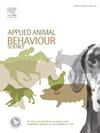三种处理和约束方法对断奶前牛肉犊牛急性疼痛和应激行为指标的比较
IF 2.2
2区 农林科学
Q1 AGRICULTURE, DAIRY & ANIMAL SCIENCE
引用次数: 0
摘要
在加拿大西部,断奶前的小牛在大约6-12周龄时进行加工,当时它们被单独处理并进行各种饲养程序。在畜牧业过程中保护动物福利的最佳实践建议建议使用冷静、安静的处理技术和适当的约束,但对“适当约束”的方法知之甚少。在加拿大西部,最常见的处理和约束小牛的方法是套绳和摔跤(RW),套绳和北叉(RNF),以及使用倾斜桌(TT)。因此,目的是比较这三种方法在行业相关条件下对疼痛和应激反应行为指标的影响。选取117头肉牛分为3组(RW组、RNF组和TT组),每组39头(加工组30头,对照组9头)。对照小牛按照其指定的组进行处理和约束,但不进行任何加工程序。处理过程包括耳部标记、疫苗接种、耳部生长植入物、手术阉割、记录保存和口服镇痛给药。录像用于量化处理和约束的持续时间,以及与主动应激或疼痛反应相关的行为。处理和约束时间最长的是TT小牛。搬运难度与搬运方法无关。在加工过程中,RNF犊牛的发声率最高,分别比RW和RW高约6-10次/分钟(P <; 0.05),而TT犊牛的挣扎率分别比RW和RNF高约2-3次/分钟(P <; 0.05)。释放后,RNF犊牛与其他组相比,释放后跑步的发生率更高(P <; 0.05)。加工后,各组间踩踏率存在差异,RNF犊牛踩踏率最高,RW犊牛次之,TT犊牛次之(RNF: 1.9 [2.3];Rw: 1.0 [0.9];Tt: 0.5 [0.5];P & lt; 0.01)。没有观察到任何小牛受伤。对不同处理方法中主动应对疼痛和压力的多种行为指标进行比较,并没有表明任何一种方法对动物福利明显是可取的或有害的。个体行为的差异,例如在约束和处理期间的挣扎或之后的跺脚,支持对每种处理方法的具体福利考虑进行进一步调查。本文章由计算机程序翻译,如有差异,请以英文原文为准。
Comparison of behavioural indicators of acute pain and stress during and after three methods of handling and restraint for pre-weaned beef calves
Pre-weaned beef calves in western Canada are processed at approximately 6–12 weeks of age, when they are individually handled and restrained to conduct various husbandry procedures. Best practice recommendations for safeguarding animal welfare during husbandry procedures suggest using calm, quiet handling techniques and proper restraint, but little is known about methods of “proper restraint”. The most common methods for handling and restraining calves in western Canada are roping and wrestling (RW), roping and Nord fork (RNF), and using a tilt table (TT). Thus, the objective was to compare the effects of these 3 methods on behavioural indicators of pain and stress responses under industry relevant conditions. A total of 117 beef bull calves were assigned to 3 groups (RW, RNF, or TT), consisting of 39 bull calves each (30 processed calves, 9 control calves). Control calves were handled and restrained according to their assigned group but did not undergo any processing procedures. Processing included ear tagging, vaccinations, growth implant in the ear, surgical castration, record keeping, and oral analgesic administration. Video recordings were used to quantify duration of handling and restraint, and behaviours associated with active stress or pain responses. Duration of handling and restraint was longest for TT calves. Handling difficulty was not related to handling method. Vocalization rate was highest for RNF calves during processing by approximately 6–10 counts/min over TT and RW, respectively (P < 0.05) and struggling rate was higher for TT calves by approximately 2–3 counts per minute vs RW and RNF, respectively (P < 0.05). Upon release, RNF calves had a higher occurrence of running upon release compared to the other groups (P < 0.05). After processing, foot stomping rate differed among groups and was highest for RNF calves, followed by RW calves, then TT calves (RNF: 1.9 [2.3]; RW: 1.0 [0.9]; TT: 0.5 [0.5]; P < 0.01). No injuries were observed in any calves. Comparison of multiple behavioural indicators of active coping with pain and stress between the handling methods did not indicate any individual method was clearly preferable or detrimental method for animal welfare. The variation in individual behaviours, such as struggling during restraint and processing or foot stomping after, supports further investigation into specific welfare considerations of each handling method.
求助全文
通过发布文献求助,成功后即可免费获取论文全文。
去求助
来源期刊

Applied Animal Behaviour Science
农林科学-行为科学
CiteScore
4.40
自引率
21.70%
发文量
191
审稿时长
18.1 weeks
期刊介绍:
This journal publishes relevant information on the behaviour of domesticated and utilized animals.
Topics covered include:
-Behaviour of farm, zoo and laboratory animals in relation to animal management and welfare
-Behaviour of companion animals in relation to behavioural problems, for example, in relation to the training of dogs for different purposes, in relation to behavioural problems
-Studies of the behaviour of wild animals when these studies are relevant from an applied perspective, for example in relation to wildlife management, pest management or nature conservation
-Methodological studies within relevant fields
The principal subjects are farm, companion and laboratory animals, including, of course, poultry. The journal also deals with the following animal subjects:
-Those involved in any farming system, e.g. deer, rabbits and fur-bearing animals
-Those in ANY form of confinement, e.g. zoos, safari parks and other forms of display
-Feral animals, and any animal species which impinge on farming operations, e.g. as causes of loss or damage
-Species used for hunting, recreation etc. may also be considered as acceptable subjects in some instances
-Laboratory animals, if the material relates to their behavioural requirements
 求助内容:
求助内容: 应助结果提醒方式:
应助结果提醒方式:


